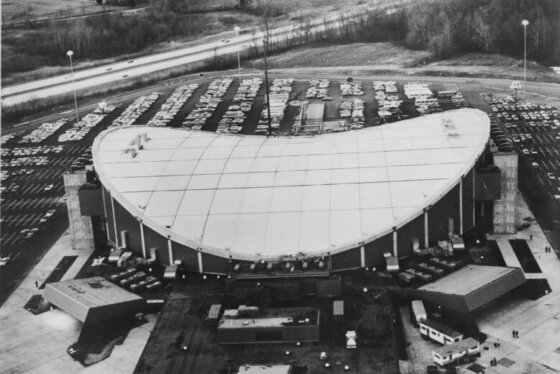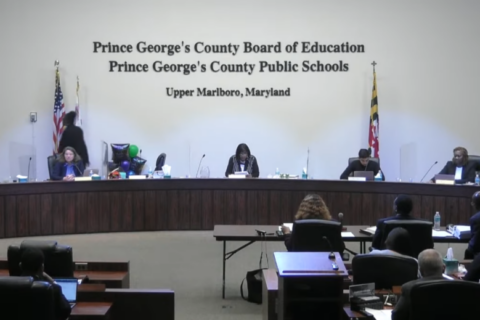It’s been closed for more than 20 years, but it’s still a venue that so many D.C.-area natives remember.
This weekend, there will be a celebration marking the 50th anniversary of the opening of the Capital Centre in Landover, Maryland.
The arena made history when it opened in December of 1973, and would continue to make history until it was shuttered in the late 1990s, replaced by what is now downtown D.C.’s Capital One Arena. It sat just outside the Outer Loop of the Capital Beltway at Arena Drive, not far from where a hospital and Metro station sit today.
This weekend, former employees and others who want to celebrate the venue will gather to mark its 50th anniversary. Several hundred names are on the list to attend.
Earlier this month, WTOP spoke with Jim Pollin, the son of philanthropist and former owner Abe Pollin, and Mary Davis, who was the vice president of employee and administrative services under Abe Pollin, about the history of the venue and the upcoming celebration.
“When I drive by and look at the Metro, I just think, ‘Why didn’t they bring the Metro out there when the arena was out there?'” Pollin said with a laugh. “Can’t figure that out. Can’t figure out why the Metro was not out there when the arena was out there.”
One thing he remembers from the start of construction was finding snake eggs on the ground as the bulldozers started to get to work.
“Prince George’s County said, ‘No, you cannot build an arena here, because it’s a swamp and nothing, and you’ll never be able to develop this area.’ And look at it now. I mean, on both sides of the Beltway, and where the football stadium is,” Pollin said. “It’s amazing.”
The arena opened Dec. 2, 1973, hosting a game between the basketball team then known as the Capital Bullets and the Seattle SuperSonics. It was revolutionary in that it was the first sporting venue to offer a video board so fans could see instant replays or other broadcasts inside the arena.
It was also used to get the crowds going, leading chants such as “Let’s go Bullets, let’s go Caps,” Pollin said.
“They were abled with cameras to take pictures of the crowd and project it up. There were wedding proposals done up on the screen. It was the first board of that type,” Pollin said.
“The first day … everything was done so quickly, there really was no time to really test it,” Pollin said. “So, it was the game against Seattle and they had the ceremony and they push the switch and it came on and everybody just breathed a sigh of relief. It was just amazing. And then, throughout the game, I mean people were just in awe to see the replays, to see everything that the board brought to the game, all the different aspects that we didn’t have before that.”
How did it come about? Davis said a high school friend of Abe Pollin’s was working on projection technology for the Department of Defense at the time the arena was being built.
“And they got together and they said, ‘Well, why can’t we put this in the building?'” Davis said.
The box office was also the first to utilize electronic ticketing. In the past, you’d have to go somewhere to buy a hard ticket, and if a store or one box office window ran out, you’d have to go someplace else and hope they still had a stack.
“It wasn’t computerized so that you would have certain locations at one entrance, certain locations at another entrance, at certain locations like downtown. So you never had access to ticketing,” Pollin said, until the Capital Centre was built.
The first luxury boxes, known as sky suites, were also built there, as was the first quiet room for children.
“Mr. Pollin came up with the idea of the quiet room because it is out in Landover, Maryland, at the time, and you had people coming from all over, especially Virginia,” Davis said. “What are parents doing when they bring their kids to a concert they want to see, like a kid’s concert or something like that? And so they took the Capital Club, which was a dining area, high revenue, [or] could have been, but Mr. Pollin turned it into a place for parents to come and sit, have dinner free of charge, while their kids were watching whatever show they might see.”
Years later, bad weather in D.C. meant the Capital Centre hosted two presidential inauguration ceremonies. Jan. 20, 1985, was so cold in D.C., the inaugural parade was canceled downtown and rescheduled for the next day at the Capital Centre. Those who were supposed to perform in the parade, including hundreds of students, performed there instead.
In 1993, the Landover venue hosted a gala celebrating the election of Bill Clinton the night before his inauguration. Performers included Michael Jackson, Elton John and a variety of other A-list stars.
But Jim Pollin’s favorite memory at the building involves a visit from another president. In 1979, the Bullets met the Atlanta Hawks in an Eastern Conference Finals series that went seven games. Then-president Jimmy Carter, a Georgia native and fan of the Hawks, showed up as a guest of Abe Pollin’s.
“He said, ‘I am the President of the United States, I’m neutral.’ And you can see throughout the game that he wasn’t neutral, and you can’t blame him. That’s his state, you know,” Jim Pollin said with a smile. “So, he walked with the Secret Service so they could get out before the game is over to go out. And he stopped. He wouldn’t leave until the last basket, and the Bullets score the last basket and he was just like, ‘Damn,’ and he walked out of the arena.”
“He was such a nice guy to sit with, and Rosalynn Carter as well. But that … it was funny to see that,” Jim Pollin said.
When friends and family (and hundreds of former employees who still keep in touch with each other all these years later) gather this Sunday, a new Capital Centre legacy website will be unveiled, including a special section that’s just for former workers. A new book marking 50 years since the opening of the Capital Centre will also be available. Then there are plans to celebrate what would have been the 100th birthday of the late Abe Pollin, who died in 2009 at the age of 85.
“If you talk to any employee, they will tell you it was Abe Pollin, and Mrs. Pollin, we have to remember that she was an owner, too. But he was the one that we worked with the most every single day. His kindness, his generosity, people don’t know. And they will never know how much he did,” said Davis.
Today, Davis is part of the faculty at Georgetown University’s Sports Industry Management program.
“One of the classes I teach is corporate social responsibility. And I tell my students that Abe Pollin started CSR in sports. It wasn’t happening with other teams,” Davis said. “He’s the one that started getting the players to get out there and meet the community long before any other team — and he didn’t do it as a business plan or as a marketing ploy. He did it because it was the right thing to do.”
“My father would walk into the arena and look around and he’d say, ‘Damn it, our ticket prices are too high. I don’t see enough kids in here,'” Jim Pollin said. “All he wanted was to bring in kids and have families in the arena. Everything came from the heart. It just came from the heart. And I don’t think you can see that in sports anymore. When he would walk in the arena, and especially like for a circus or for a game and you’d see families and kids and he was just so happy.”
The arena hosted concerts, too. In fact, two days after opening, the Allman Brothers Band played until 3:30 a.m. the next morning.
“There was all this smoke because it was an Allman Brothers concert, and you can imagine where that smoke was coming from,” Davis said. “And Mr. Pollin yelled … ‘Call the fire department! Call the fire department! My arena is on fire!’ It was ‘No, no, Mr. Pollin. It’s OK.'”
Davis also shared the story of the time Abe Pollin put Frank Sinatra in his place right before a concert.
“Mr. Pollin, again because of his philanthropic approach, really wanted to do something. He had arranged for Frank to do a meet and greet with all of these people, but they had to pay for it and all that money was going to go to charity. So they waited and they waited, I think Frank was supposed to be there by 5 [p.m.] before the event. He didn’t get there until right before performance time. And he comes in the building and Mr. Pollin said to … the producer, and he said, ‘We’re not starting this event until Frank Sinatra meets with all these people.’
“So, basically, what happened was that he had to agree to Mr. Pollin that he would stay after the concert and do the meet and greet with all the people. And they made him stay in the building and he did it, I don’t want to say reluctantly, but you know, he had a plane to catch,” Davis said.
“But that was kind of person Mr. Pollin was. Nobody is above anybody else and he made this agreement and he wanted to see that he saw it through. And Frank did, which was good. It was just about midnight, I think, before he got out, though.”









